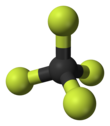Carbon tetrafluoride
| |||

| |||
| Names | |||
|---|---|---|---|
| IUPAC names
Tetrafluoromethane
Carbon tetrafluoride | |||
| Other names
Carbon tetrafluoride, Perfluoromethane, Tetrafluorocarbon, Freon 14, Halon 14, Arcton 0, CFC 14, PFC 14, R 14, UN 1982
| |||
| Identifiers | |||
3D model (
JSmol ) |
|||
| ChEBI | |||
| ChemSpider | |||
ECHA InfoCard
|
100.000.815 | ||
| EC Number |
| ||
PubChem CID
|
|||
RTECS number
|
| ||
| UNII | |||
CompTox Dashboard (EPA)
|
|||
| |||
| |||
| Properties | |||
| CF4 | |||
| Molar mass | 88.0043 g/mol | ||
| Appearance | Colorless gas | ||
| Odor | odorless | ||
| Density | 3.72 g/L, gas (15 °C) | ||
| Melting point | −183.6 °C (−298.5 °F; 89.5 K) | ||
| Boiling point | −127.8 °C (−198.0 °F; 145.3 K) | ||
| 0.005%V at 20 °C 0.0038%V at 25 °C | |||
| Solubility | soluble in benzene, chloroform | ||
| Vapor pressure | 3.65 MPa at 15 °C 106.5 kPa at −127 °C | ||
Henry's law
constant (kH) |
5.15 atm-cu m/mole | ||
Refractive index (nD)
|
1.0004823[1] | ||
| Viscosity | 17.32 μPa·s[2] | ||
| Structure | |||
| Tetragonal | |||
| Tetrahedral | |||
| 0 D | |||
| Hazards | |||
| Occupational safety and health (OHS/OSH): | |||
Main hazards
|
Simple asphyxiant and greenhouse gas | ||
| NFPA 704 (fire diamond) | |||
| Flash point | Non-flammable | ||
| Safety data sheet (SDS) | ICSC 0575 | ||
| Related compounds | |||
Other anions
|
Tetraiodomethane
| ||
Other cations
|
Tin tetrafluoride
Lead tetrafluoride | ||
Related fluoromethanes
|
Fluoromethane Difluoromethane Fluoroform | ||
Except where otherwise noted, data are given for materials in their standard state (at 25 °C [77 °F], 100 kPa).
| |||
Tetrafluoromethane, also known as carbon tetrafluoride or R-14, is the simplest
Bonding
Because of the multiple carbon–fluorine bonds, and the high
Preparation
Tetrafluoromethane is the product when any carbon compound, including carbon itself, is burned in an atmosphere of fluorine. With hydrocarbons,
Although it can be made from a myriad of precursors and fluorine, elemental fluorine is expensive and difficult to handle. Consequently, CF
4 is prepared on an industrial scale using hydrogen fluoride:[3]
- CCl2F2 + 2 HF → CF4 + 2 HCl
Laboratory synthesis
Tetrafluoromethane and silicon tetrafluoride can be prepared in the laboratory by the reaction of silicon carbide with fluorine.
- SiC + 4 F2 → CF4 + SiF4
Reactions
Tetrafluoromethane, like other fluorocarbons, is very stable due to the strength of its carbon–fluorine bonds. The bonds in tetrafluoromethane have a
It is very slightly soluble in water (about 20 mg⋅L−1), but miscible with organic solvents.
Uses
Tetrafluoromethane is sometimes used as a low temperature refrigerant (R-14). It is used in electronics microfabrication alone or in combination with oxygen as a plasma etchant for silicon, silicon dioxide, and silicon nitride.[7] It also has uses in neutron detectors.[8]
Environmental effects



Tetrafluoromethane is a potent
Tetrafluoromethane is the most abundant
Although structurally similar to
Main industrial emissions of tetrafluoromethane besides
Health risks
Due to its density, tetrafluoromethane can displace air, creating an
See also
- Trifluoromethane
- Hexafluoroethane
- Octafluoropropane
References
- .
- .
- ^ ISBN 978-3527306732.
- PMID 18197347.
- ^ PMID 14703372.
- ISBN 978-0-08-037941-8.
- ^ K. Williams, K. Gupta, M. Wasilik. Etch Rates for Micromachining Processing – Part II J. Microelectromech. Syst., vol. 12, pp. 761–777, December 2003.
- .
- ^ Artaxo, Paulo; Berntsen, Terje; Betts, Richard; Fahey, David W.; Haywood, James; Lean, Judith; Lowe, David C.; Myhre, Gunnar; Nganga, John; Prinn, Ronald; Raga, Graciela; Schulz, Michael; van Dorland, Robert (February 2018). "Changes in Atmospheric Constituents and in Radiative Forcing" (PDF). Intergovernmental Panel on Climate Change. p. 212. Retrieved 17 March 2021.
- ^ "Climate change indicators - Atmospheric concentration of greenhouse gases - Figure 4". United States Environmental Protection Agency. 27 June 2016. Retrieved 2020-09-26.
- NOAAGlobal Monitoring Laboratory/Earth System Research Laboratories.
- S2CID 34911990.
- ^ "Bond Energies". www2.chemistry.msu.edu. Retrieved 2023-01-15.
- ISSN 0094-8276.
External links
- International Chemical Safety Card 0575
- National Pollutant Inventory – Fluoride and compounds fact sheet
- Data from Air Liquide Archived 2011-07-21 at the Wayback Machine
- Vapor pressure graph at Air Liquide
- MSDS at Oxford University
- Protocol for measurement of tetrafluoromethane and hexafluoroethane from primary aluminium production
- Chemical and physical properties table
- WebBook page for CF4



